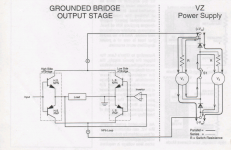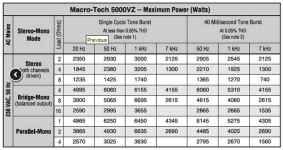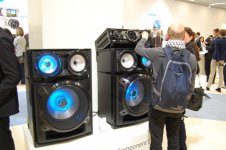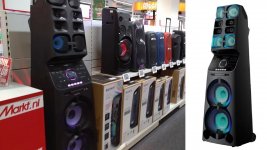When it comes to 'proper' definitions, I can be criticized as well. IF you did not do 4 years at MIT, usually the way you describe various waveforms, drive mechanisms, etc can be colorful to those who had certain definitions pounded into them, or face failure on a test. Back about 35 years ago, I was 'called out' by Bob Pease (also ex MIT student, remember him?) for using 'inappropriate' descriptions of what I was finding in the CAP DA test that Scott Wurcer invented (at least he contributed the INAMP). He told me that I was no 'engineer' and therefore I could not know what I am talking about and he did not want to discuss with me further. Oh well, we sited him anyway in our article, because it was the professional thing to do.
I had seen this before in 1977, when Matti Otala (Dr in engineering, and full professor at times) got criticized by Dr. Cherry, for using the word 'overload', instead of 'overdrive'. Oh joy! '-) Cherry also did not like the term (TIM) but wanted to rename the distortion 'slope distortion'. Of course, where was he when he wrote a nearly 1000 page book on amplifier design in the late 60's, and did not mention any sort of 'rate related' distortions in his book? And so it goes.
I won't follow every nit-pick and criticism printed here, because most are trivial and virtually meaningless. However, whether Joe has done something useful, or not, is not for me to determine, nor any of the rest of you, without seriously trying it first.
I had seen this before in 1977, when Matti Otala (Dr in engineering, and full professor at times) got criticized by Dr. Cherry, for using the word 'overload', instead of 'overdrive'. Oh joy! '-) Cherry also did not like the term (TIM) but wanted to rename the distortion 'slope distortion'. Of course, where was he when he wrote a nearly 1000 page book on amplifier design in the late 60's, and did not mention any sort of 'rate related' distortions in his book? And so it goes.
I won't follow every nit-pick and criticism printed here, because most are trivial and virtually meaningless. However, whether Joe has done something useful, or not, is not for me to determine, nor any of the rest of you, without seriously trying it first.
Last edited:
However, whether Joe has done something useful, or not, is not for me to determine, nor any of the rest of you, without seriously trying it first.
Are yourself planning "to try it first"? That could certainly be stimulating for pitchfork wielding MIT graduates around.
Of course, where was he when he wrote a nearly 1000 page book on amplifier design in the late 60's, and did not mention any sort of 'rate related' distortions in his book? And so it goes.
Of course the term slew rate dates from WWII (at least).
the way you describe various waveforms, drive mechanisms, etc can be colorful to those who had certain definitions pounded into them
No problem with "colorful", provided the perpetrator doesn't claim he discovered something new and unknown by the unwashed masses of MIT graduates. Rejecting the known/common definitions/language (if available) also doesn't help in stimulating the decoding process.
Yes, Slew rate was taken from guns, etc, swiveling. TIM is not 'slew rate' but what can happen BELOW slew rate, usually an ignored measurement for many decades. It must be remembered that we still use 1KHz Harmonic and SMPTE IM as standards for audio products. These tests are not very sensitive to a relatively low slew rate, and that is why we had to go out to 20KHz harmonic distortion and above (Walt Jung) and TIM (sine-square) Otala to truly measure the problem. Of course, when the first IC op amps were introduced, they had (generally) really low slew rate, and this was when it became something added on the data sheet. Cherry completely ignored this in his nearly 1000 page book. If it was so obvious, why did he not mention it?
I wonder myself, is it applicable to the actual sound wave that reach our ears? All I have discovered is about measurement issues.Just like the term hi-fi. Some have their own definition of it and try to push it.
Last edited:
I mean the spectral nature of the control/dumping of return energy, and yes I understand the maths and yes the MA-5000 spec has always been moot.
PS - How do you get 5kW down the 240V/15A AC cord ??.
If you understand the math do it and show us, MAYBE then you will understand it, the rest is BS.
Other than speakers (and its room interactions), how else would you determine the faithfulness of its output to its input of each component prior to speaker terminals? By using our ears?I wonder myself, is it applicable to the actual sound wave that reach our ears? All I have discovered is about measurement issues.
Max,
I use 208 volts and 30 of them ampy thingies. Still never delivers 5,000 watts from both channels. It can do a bit better than 2,500 watts single channel driven.
I use 208 volts and 30 of them ampy thingies. Still never delivers 5,000 watts from both channels. It can do a bit better than 2,500 watts single channel driven.
Yes, Slew rate was taken from guns, etc, swiveling. TIM is not 'slew rate' but what can happen BELOW slew rate, usually an ignored measurement for many decades.
Known as large signal BW and input transfer function. I know we all stared drooling on the floor trying to figure out where distortion came from. Jim Roberge had the large signal tri-wave test for input transfer function in his text books by 1970 or so. I showed using it in my AES preprint to both demonstrate crossover and input error signal needed at max slew vs frequency. Otala BTW applied square waves he mentions tri-waves as only showing static non-linearity which is wrong or at least a poor way of looking at it (shame on you, you made me peak at the original again). Actual hard slew is dysfunctional for any amplifier and there is not much point in looking at it since anything can happen there is no useful information except that everything is broken and there is no possibility of any fidelity.
Last edited:
Class D ?


Service manual
Hi Bob, these Crown amps are linear amplifiers running in 'grounded bridge' mode as per above diagram with floating series/parallel switched power supply arrangement. The SM linked explains the concepts.
Dan.
That ought make quite a racket. The local rental companies here run racks and racks of these to run stacked subs across full width of front of stage. Word from sound guys is that nothing else delivers bottom end like these do.Max, I use 208 volts and 30 of them ampy thingies. Still never delivers 5,000 watts from both channels. It can do a bit better than 2,500 watts single channel driven.
Dan.
There is a reason for that, most of the power amplifiers give a power rating for a 10 millisecond burst. The Crown rating is continuous.
Didn't you ever wonder how folks make 10,000 watt amplifiers?
QSC last I looked also used continuous ratings.
Didn't you ever wonder how folks make 10,000 watt amplifiers?
QSC last I looked also used continuous ratings.
Sure...I know them on the inside, quite a beast, especially back when they were new/unique.There is a reason for that, most of the power amplifiers give a power rating for a 10 millisecond burst. The Crown rating is continuous.QSC last I looked also used continuous ratings
Here are the Tone Burst specs.

Yeah, cheap 10,000W home systems, sure thing lol. And this Samsung 4000W Giga System...Didn't you ever wonder how folks make 10,000 watt amplifiers?

And this Sony MHC - V90DW 2000W

Ed, jazz up your next church install, 1.7m tall, just put one each side of stage lol.
Dan.
Do you find fidelity prior to speaker terminal good enough for you? I find the lack of information on fidelity of the actual sound reaching our ears kind of misleading, keeps a big enough space for the snake oil peddlers to stay alive.Other than speakers (and its room interactions), how else would you determine the faithfulness of its output to its input of each component prior to speaker terminals? By using our ears?
@scottjoplin,
Isn't it more that people believe to understand?
If you know about the conditions of the measurement and/or know that they are coming from the same source, then of course then the number can help.
Mainly along with other numbers from additional measurements, but I was responding to the quoted assertion about the reactive loads.
Overall the so-called "power cubic" is the most informative, but unfortunately not that widely used.
@Evenharmonics,
In this context of a measured number, reactive loads and unknown measurement conditions, any question about listening tests is ...um.... quite strange.
Seems that you're fooling yourself again; did I already mention Feynman's remarks on that?
(Hint; no he did not try to sell .... snake oil "whatever") 🙂
@chris719,
Such jokes are not that easy to spot if used twice and the second time in this context:
"Tinfoil hat nutjob guy and his asphalt repair coating, or products made and characterized for the purpose?"
Raises the question which way you were able to identify which product was used for the purpose under the coating?
Btw, the complaint about the nonmodified JTAG connector seems to contradict the premise that the pcb couldn't benefit from any treatment?!
Could you elaborate a bit?
Of course, it is a single number. It still has a useful meaning that people understand
Isn't it more that people believe to understand?
If you know about the conditions of the measurement and/or know that they are coming from the same source, then of course then the number can help.
Mainly along with other numbers from additional measurements, but I was responding to the quoted assertion about the reactive loads.
Overall the so-called "power cubic" is the most informative, but unfortunately not that widely used.
@Evenharmonics,
As you already know, this is audio device so the audible aspect is the core issue, which brings up the following question. What about the listening test?
In this context of a measured number, reactive loads and unknown measurement conditions, any question about listening tests is ...um.... quite strange.
Seems that you're fooling yourself again; did I already mention Feynman's remarks on that?
(Hint; no he did not try to sell .... snake oil "whatever") 🙂
@chris719,
Driveway sealant was a joke. I have no idea what his conformal coating is, but I don’t have high hopes for efficacy given that his other weapon of choice is actually duct tape placed in what appear to be random locations.
Such jokes are not that easy to spot if used twice and the second time in this context:
"Tinfoil hat nutjob guy and his asphalt repair coating, or products made and characterized for the purpose?"
Raises the question which way you were able to identify which product was used for the purpose under the coating?
Btw, the complaint about the nonmodified JTAG connector seems to contradict the premise that the pcb couldn't benefit from any treatment?!
Could you elaborate a bit?
Sarcasm may not always be obvious in forum posts. Some people pick it up more easily than others. Might be harder if English is not your first language.
I really don't care to get into one of your usual arguments over semantics. You're reading into things I did not say regarding the JTAG port. There also appears to be nothing under the coating, I don't know what you are talking about with that comment.
I thought my opinion on this was clear. I'll reiterate it for you if not:
The person who performs this "service" appears to have no idea what he is doing, based on claims made on his website and the pictures of the modified unit. He shows no evidence his modifications do anything at all. I suspect he might be crazy based on the articles linked on his webpage.
That's all that needs to be said on this topic, really.
I really don't care to get into one of your usual arguments over semantics. You're reading into things I did not say regarding the JTAG port. There also appears to be nothing under the coating, I don't know what you are talking about with that comment.
I thought my opinion on this was clear. I'll reiterate it for you if not:
The person who performs this "service" appears to have no idea what he is doing, based on claims made on his website and the pictures of the modified unit. He shows no evidence his modifications do anything at all. I suspect he might be crazy based on the articles linked on his webpage.
That's all that needs to be said on this topic, really.
Last edited:
They believe bigger is better, that's why it sounds better than a measure of output impedance, it amounts to the same thing.Isn't it more that people believe to understand?
Spurs. But not very seriously.
As I said, it is a scaled number.
Nice postl, So I will respond. Of course I have been keeping an eye on the Christian Eriksen saga. Would love him at Man U. Eriksen comes from a town that I am quite familiar with. Don't laugh, it is called Middelfart. True! And this time you can't say I am not telling the truth. 😀
DF is a scaled number, but it serves no purpose. Langford-Smith disassociated himself from the term in Wireless World. He was the one who invented it and then admitted he was wrong.
Neville Thiele and Richard Small both disassociated themselves from it, I know because I spoke to Small personally and the very idea annoyed him and I was taken aback because I was the believer in DF and he set me straight. Took me years to understand. The names Thiele & Small must surely be know to you. You are familiar with them? Just asking.
If you mean output impedance, then just say it.
And oh, in what EE textbook is DF described? If EE language is important, you should be able to find it. Can you???
Just asking, peace!
If the amp is linear or nearly linear then output impedance covers both situations. The exception might be an amp with poorly designed current limiting, but I get the impression that nowadays people don't use current limiting very much but just have lots of transistors and huge heatsinks instead.Max Headroom said:Sure DF is a measure of how well an amp delivers energy but it says nothing about how an amp can't cope with return energy.
It is defined to be wrt the nominal speaker impedance. By definition it takes no account of reactive loads. However, this does not mean that it tell you nothing about behaviour with reactive loads. DF is a scaled measure of output impedance, usually at low frequencies. If it is used for what it is intended for then it is useful. Like all amplifier measures, it is unwise to misuse it and it is unwise to ignore it.Jakob2 said:It is of questionable merit because it is most often not known under which conditions it was measured. Which frequency, which level?
Usually it is spec'ed wrt to an idealized loudspeaker impedance of 4 or 8 Ohms without any relation to a reactive load.
If a claim is demonstrably false, because it relies on private versions of physics, then there is no need to try it in order to refute it.john curl said:However, whether Joe has done something useful, or not, is not for me to determine, nor any of the rest of you, without seriously trying it first.
Perhaps where you went wrong was being a "believer in DF"? That sounds rather like putting a number/concept on a pedestal, as people sometimes do with their leaders. Eventually reality sets in and the thing has to be knocked off its pedestal. The believer than becomes a fervent unbeliever.Joe Rasmussen said:Neville Thiele and Richard Small both disassociated themselves from it, I know because I spoke to Small personally and the very idea annoyed him and I was taken aback because I was the believer in DF and he set me straight.
Much better to have a sober view. DF (and THD etc.) tells you something; it is equally daft to think it tells you everything or nothing. DF is a scaled measure of output impedance. Scaled measures play a useful role in science and engineering.
- Status
- Not open for further replies.
- Home
- Member Areas
- The Lounge
- John Curl's Blowtorch preamplifier part III